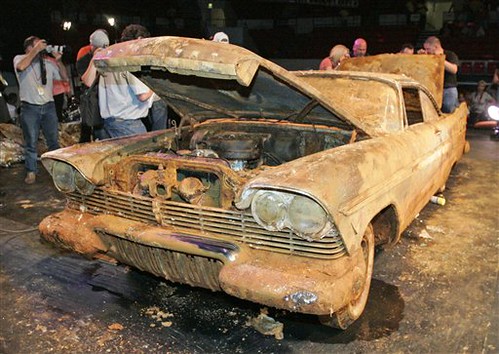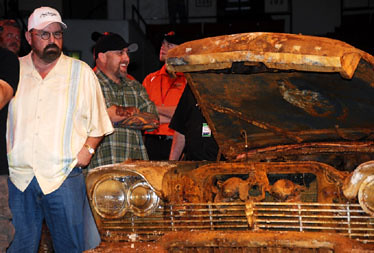
The 1957 Plymouth Belvedere, aka Miss Belvedere, that was unearthed from a Tulsa time capsule to much fanfare in 2007, is sitting in a New Jersey warehouse, apparently unwanted, according to a recent story in Hemmings Motor News.
Because water inundated the vault during its 50-year residence, rust and mud covered the Belvedere and rendered it inoperable. The good news is Ultra One, a rust-removal company, did a bang-up job ridding the grime and corrosion from the car’s body, as you can see in a series of photos here.

Despite the car’s improved looks, its poor condition is the primary reason no one wants it:
Late last year, news surfaced that Foster, with Carney’s permission, was attempting to donate the car to the Smithsonian Institution in Washington, D.C. While it’s known as “America’s attic,” Smithsonian representatives told Foster that they do not see it as “America’s garage,” and the offer was rebuffed, leaving Foster in continued possession of the car. The city of Tulsa also turned down Foster’s request to send it back home for public display, noting that the cost to retrieve a rusted and useless car from an old tomb (and, presumably, the giant letdown experienced collectively by the town) still left a bitter taste in some residents’ mouths.
As Miss Belvedere sits today, its condition remains largely unchanged since 2009, with all of the reasonable preservation work done that could be done. From a distance, the car almost looks presentable, but up close it becomes evident that the damage is irreversible. Foster compares the car’s frame to papier mâché, admitting that “there are spots I could put my hand through if I’m not careful.” Utilizing the frame from the donor Plymouth Savoy would be an option if Miss Belvedere were stronger, but the car’s sheetmetal is in equally poor condition, especially in the rear. While the exterior has been cleaned, the interior of the body is still caked with mud, and as Foster said, “this is actually shoring up the body panels.” The car’s laminated safety glass is damaged beyond repair after water seeped between the glass and plastic layers during the car’s years in storage. While the steering was functional at first, the steering box is “melted inside,” the result of years of corrosion, and none of its electrical systems are even close to functioning. Even transporting the car to another location would be a major undertaking, given Miss Belvedere’s fragile condition.
The car remains in the custody of Robert Carney and two other relatives of Raymond Humbertson, who was the closest to guess Tulsa’s 2007 population 50 years ago and thus won the car (Humberton was deceased when the Belvedere was unearthing). Carney still holds hope he can find an Oklahoma museum to display it permanently.
Although many regarded the Belvedere reveal as a bust, it remains one of the biggest publicity stunts I’ve seen. Thousands of people descended on Tulsa to view it (and drove Route 66 while they were at it). Many more checked out the festivities and news stories online. I worked at the Tulsa World newspaper at the time, and online traffic taxed the company’s servers like no story had before. One reporter said memorably in a column: “This story didn’t have just legs; it had stilts.”
And just days after Hemmings published its story, it gained more than 240 comments from readers. Years later, the Belvedere is still a phenomenon.
The Hemmings story closes with this poignant observation:
Until Foster finds a museum or other sympathetic caretaker willing to embrace Miss Belvedere, however, it sits in a corner of the Ultra One warehouse, free from its watery tomb but no less trapped in time and place.
(Photos of Miss Belvedere by Todd Lappin and That Hartford Guy via Flickr)


Miss Belvedere would be cruising the streets today if had simply been put-up on blocks in an Oklahoma barn in 1959, had it’s fluids drained and then covered with a heavy canvas tarp. As a “Barn-Find”, it would have survived like thousands of others before her.